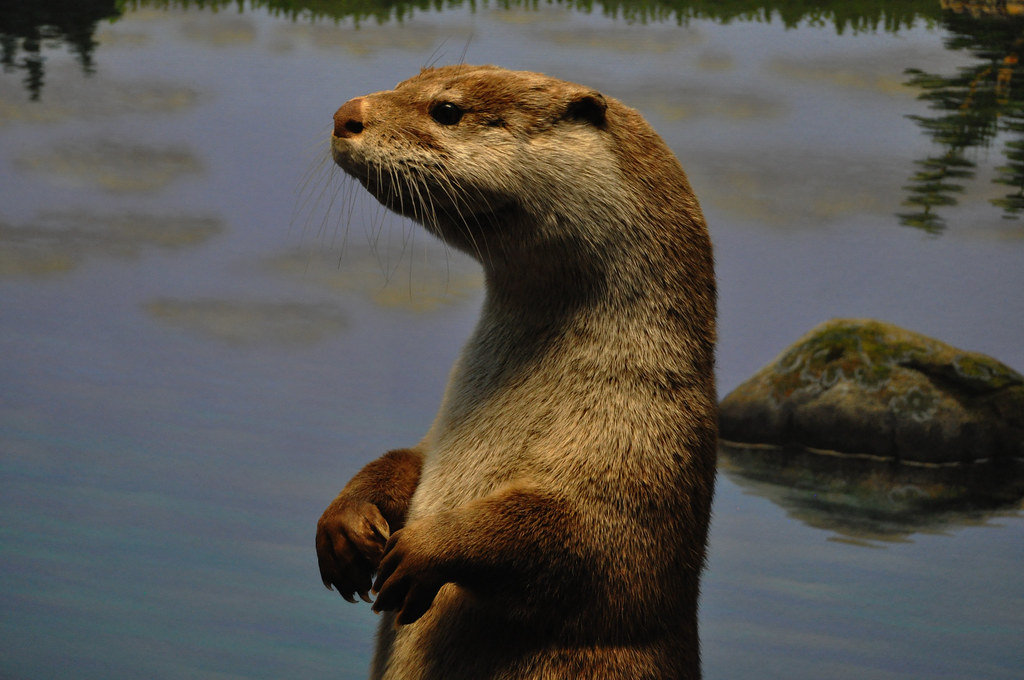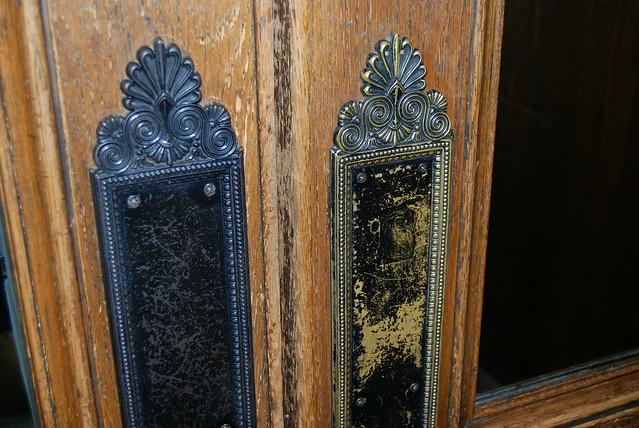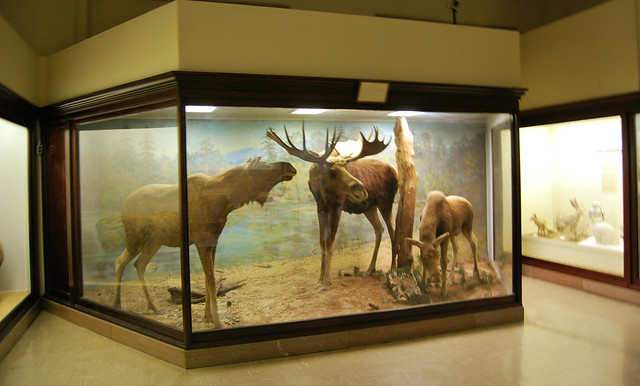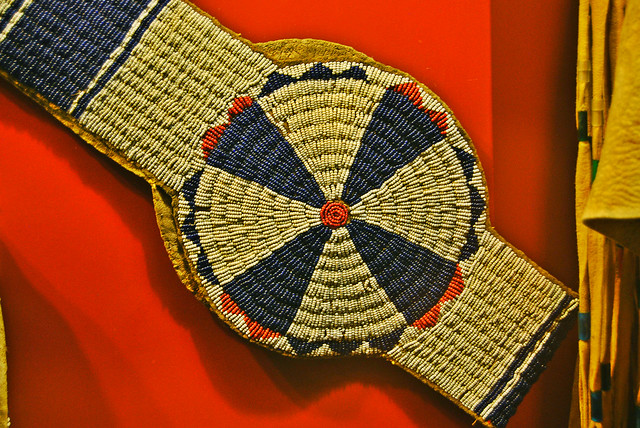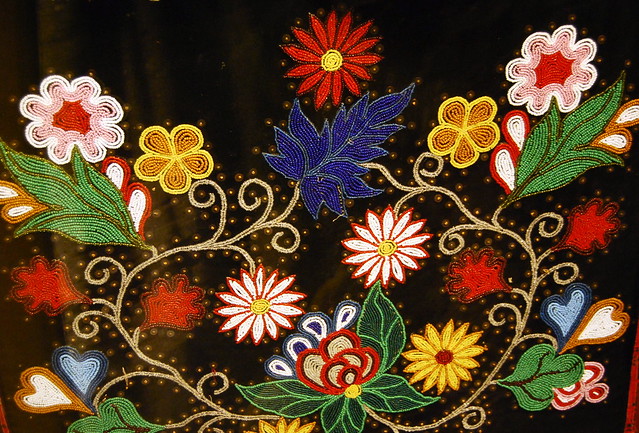Showing posts with label MacBride Hall. Show all posts
Showing posts with label MacBride Hall. Show all posts
Saturday, June 30, 2018
A Day at the Museum of Natural History - Macbride Hall
Hidden in plain site on the University of Iowa's main campus is the Museum of Natural History at Macbride Hall located on the pentacrest. The museum occupies sections of three floors. On the third floor's Mammal Hall is home to a collection of large and small mammals from all over the world.
Some of the larger taxidermized animals where prepared over a hundred years ago. If you look closely you can see cracks in the skin from years of heat and light exposure.
As a active museum students often participate in cleaning and modernizing the displays. Several of the background murals have been retouched or repainted over the years to give the display a fresh look.
Throughout the year and especially in the summer, school age students visit the Mammal Hall, Bird Hall and the Natural History portion of the museum. Text near the displays explain how the natural scenes came together in the early 1900s.
Some of the mammal displays are quite realistic and capture the environment of the natural setting like this otter placed in a scene from northern Minnesota. Always a favorite.
At one end of Mammal Hall is a display of ocean mammals and skeletons. Hanging above is a Right Whale skeleton that washed up on a beach over a hundred years ago. Today you can see it from the comfort of landlocked Iowa - some half a continent away from ocean shores. Access to the museum is free and is open most days except holidays and Mondays. If you are in Iowa City come check it out.
Labels:
display,
iowa,
Iowa City,
MacBride Hall,
mammals,
Museum,
natural history,
UI
Sunday, July 10, 2016
Feathery Tempation Eyes
A peacock's vivid plumage is pure art. This particular display comes courtesy from the University of Iowa's Hall of Birds located at Macbride Hall, which is part of oldest existing university museums west of the Mississippi. Be sure to visit Bird Hall, Mammal Hall and the Natural History Museum all within that building. Many students are not aware of the museums let alone visit the displays.
Saturday, January 18, 2014
A Century of Handling
These are the hand panels on the sturdy oak doors of MacBride Hall on the University of Iowa campus. The building was constructed during the first decade of the 1900s. If these panels are original to the doors just imagine how many people have touched them - its on a generational scale.
Friday, January 17, 2014
Mooses in a Glass Box
Every year there seems to be a sighting of a black bear or moose wondering around eastern Iowa. Iowa's DNR says the large animals are most likely from Minnesota, where they have treked along river, timber and corn fields in search of who knows what down here along the 42N latitude. While the latest sighting of a lone male moose was within the city limits of Cedar Rapids last month, the whereabouts of the northern creature is unknown. Here at the University of Iowa's Natural History Museum, Mammal Hall you can find a whole family of mooses. The display has been here for many years - and so have I.
Thursday, January 16, 2014
Treasure of Iowa
American native bead work, specifically Iowan is rare, detailed and a work of art. Check it out for yourself at the Iowa Natural History Museum at Macbride Hall in Iowa City, Iowa. Imagine how these are made. How do the makers get the beads? How is the pattern crafted? How long does it take to make this? Maybe someone knows.
Wednesday, July 17, 2013
Rusty the Giant Sloth To Get Company
Ice Age Iowa hosted a particularly interesting creature - a giant sloth. At the Natural History Museum at Macbride Hall, in Iowa City is this display of a life size giant sloth, nicknamed Rusty. Recently nearly complete sets of huge sloth bones have been found in the state and are being prepared to join Rusty on display. For 28 years this display has been the center point for the museum including dressing Rusty on holiday ocassions. This practice ended sometime this year as his fur has shown wear from festive use. There is no timetable for the bones to be on display but the chatter around the museum is that the display will be forthcoming soon.
Sunday, January 6, 2013
Whale Bones in Iowa
Yes, Iowa was once covered by a shallow marine sea. Today the result of that long ago sea are layers of limestone found just under the prairie soil. Some of the rock contain fossils of small marine creatures like coral, snails, fish and a few larger marine creatures.
To see these suspended whale bones you need to visit the Natural History Museum at Macbride Hall on the University of Iowa's main campus. A Right Whale's skeleton was collected early last century on a North Carolina shore and brought to the university for study and eventual display. Many a schoolchild and adult has marveled at this creature's size and bone makeup. The whale is located in the museum's mammal hall section. The other side of the building contains bird hall and is filled with all types of feathered creatures including a detailed observation post of a remote Pacific island sanctuary visited by UI researchers a hundred years ago. The lower middle portion of the building houses the third section of the museum and features a walk through Iowa's pre-history. Come check it out. Admission is always free.
Wednesday, July 11, 2012
Early Iowan was Clovis Hunter
A visit to a local museum brings you face to face with a replica of early hunters in Iowa. What has been found over the years are Clovis points. These chiseled stone tools, named for a site in New Mexico have been found all over North America including Iowa. The distinctive white stone is called Burlington chert. Clovis points found in Iowa are estimated to be from the era 10,000 to 9,000 years BC. They represent the earliest known occupiers of Iowa and coincide with the retreat of the last glacier event through these parts. The exhibit can be seen along with other points of interest at the Museum of Natural History, MacBride Hall, University of Iowa in Iowa City, Iowa.
Saturday, July 7, 2012
Touching Iowa's Glacial Past
Iowa is a land shaped by glaciers that receded some 13,000 years ago. Two of the more unique examples of what glaciers influence can be found at MacBride Hall's Natural History Museum on the University of Iowa campus in downtown Iowa City. One item is a hunk of native copper that was glacially transported here from northern Minnesota, Wisconsin or Canada. The other artifact is glacial grooved limestone where parallel scratches made from pressure and movement can be seen and felt. These items provide an ongoing opportunity for anyone to touch something created by glacial forces long ago.
The copper and limestone are positioned side by side as part of a short narrative slideshow. Yes, an old fashion, 35mm slideshow complete with tray and audio components. This particular display has been present for some thirty years and seems positively glacier-like in its ability to tell a story compared to modern audio-visual aids. Still, you get the message and can feel the history.
Monday, December 26, 2011
Iowa Native Beadwork Vest
Museums showcase many things. In between the pottery, spear points and ceremonial pipes crafted by Iowa natives (Chippewa, Mesquakie and Ioway) is this portion of a vest. It is displayed at the University of Iowa's MacBride Hall Museum of Natural History among the shoes and other outer wear.
This section of the museum is easily overlooked by students because it does not compare to the replica giant sloth (named Rusty) or display of geologic fossils. However the vest is worthy of the same scrutiny of any piece of art. Look at the design and work effort required to assemble the vest. Rusty might be able to draw the crowds of kids, but the museum's diverse display of early Iowa culture will keep them coming back for decades. Know that.
Subscribe to:
Posts (Atom)





